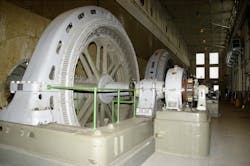A History Lesson in Standardizing Voltage and Frequency in the Electrical Industry
Most people plug in a piece of equipment and expect it to work. For the most part, electrical manufacturers produce equipment that operates without much concern from consumers. But for this scenario to work well, manufacturers must adhere to electrical industry standards when manufacturing their equipment. These standards are used to establish voltage operation thresholds for the equipment.
In the early days of electrification, voltage thresholds had not been established as a standard. Therefore, it was difficult to connect electrical equipment in different areas of the country. At the turn of the 20th century, electric machines could be built to operate at a variety of AC frequencies. In 1900, the frequency range in the United States was anywhere between 50 Hz to 133 Hz. During this time, Westinghouse generators produced power at 133 Hz, which was used for lighting and the Niagara Falls station transmitting power to Buffalo, N.Y., operated at 25 Hz. This helps explain why over the years, especially in the early days, equipment was rated at 110V, 115V, and 120V. So what exactly is nominal voltage?
Standardizing the “wild west” of electrification was needed to enable broader adoption and ease of use of electric machines and equipment. Today, a standard exists to provide nominal voltage for manufacturers of electrical equipment. This standard was developed in 1942 when the Edison Electric Institute (EEI) published the paper Utilization Voltage Standardization Recommendations (EEI Pub. No. J-8). Later, in 1949, both EEI and the National Electrical Manufacturers Association (NEMA) published what would become the American National Standard for Electrical Power Systems and Equipment-Voltage Ratings (60 Hz) (ANSI C84.1). The standard, last revised in 2016, continues to provide power producers, electric utilities, and equipment manufacturers with standard nominal voltages and frequency.
ANSI C84.1 Table 1 established the nominal voltage for low-, medium- and high-voltage service and equipment. In addition to the nominal system voltage, Table 1 provides the operational thresholds electrical equipment should operate at and the delivery of voltage to the service. Voltage range is evaluated under normal operating conditions and specifies ±5% of nominal voltage at the electrical service (typically the revenue meter). At the point of utilization (typically the equipment), the standard allows for +5/-10%.
The National Electrical Code (NEC) draws from this utilization recommendation in Sec. 210.19(A), Informational Note No. 4. This requirement states that the voltage cannot exceed a total of 5% voltage drop from the service to the furthest outlet. If the electric utility provides voltage within ±5% to the revenue meter and the internal voltage drop doesn’t exceed 5%, then the equipment should operate properly, according to the standard. ANSI C84.1 can be used to evaluate the responsibility of the electric utility, customer, and equipment manufacturer to ensure electrical equipment will operate without much concern.
About the Author
Bryan Glenn
Power Quality Consultant
Bryan Glenn is a power quality consultant for EC&M magazine. He can be reached at [email protected].

